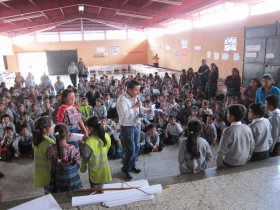
By John van Keppel, Guatemala National Director
I always find it amazing to see what one motivated librarian can accomplish when provided with training, support and resources.
I just returned from Patzún, Guatemala, where we recently began our Reading for Life program. Patzún is a small town in the country’s rugged Central Highlands, and most of the residents are indigenous Kaqchikel. There’s a small library here which, until recently, was of little use to children.
The librarian in Patzún is an indigenous woman named Marilene Ixel. She began participating in our Librarian Training Program this year, after hearing about the literacy work we’ve been doing in outlying rural schools. (Our program is open to any librarian who wants to attend, and the majority of the 60-plus participants had no resources or training before working with Child Aid.)
Marilene took immediately to the reading-promotion practices we teach in the workshops and soon decided she was ready to do something. She approached one of our literacy trainers with an outreach plan: First, she would invite a group of indigenous scholarship students to the library, and she would use the books provided by Child Aid to encourage them to visit independently and read on their own. In Guatemala, children rarely read independently, partly because books are extremely rare and partly because most teachers lack training in the basics of teaching and promoting reading.
Marilene went straight to work with the local indigenous council and, before we knew it, she had started reading hours for 135 scholarship students! These are school-age children who come from desperately poor families and who face high drop-out rates. Ongoing reading encouragement and access to books will be tremendously helpful for them.

After Marilene set up the reading hours, she decided she wanted to hold a “Festival of Reading” to promote the library among schools in the Patzún area. She visited schools, talked to directors and drummed up interest from four schools. Her initial plan was to set up a two-hour reading program for each school. To make it happen, she enlisted the help of two of our literacy trainers, Graciela Pichaya and Jorge Buch. After planning the festival, the three of them realized they needed more help. So they roped in another Child Aid literacy trainer, Jeremías Morales, and two Child Aid interns, young indigenous women from the Patzún area. Then they made it happen.
When I heard about the festival, I initially imagined they would have kids come to the library, class by class, so the children could participate in reading hours. This is what I was expecting to see when I drove out to Patzún yesterday to attend the event. But what I found was an empty library. Little did I know, Marilene had far bigger plans.
I heard a bunch of commotion in the adjacent building, and then I heard Jorge’s voice over a loudspeaker. When I walked in, I found over 250 children competing in a word game that required them to create sentences out of a jumble of cardboard words that Marilene had written and cut out. Participants were being cheered on by the rest of the school children, who rooted for their classmates to finish first.

After the game, Marilene divided the children into small groups, and she and the Child Aid staff read stories out loud to each group. After that, they invited the kids into the library, class by class, to peruse the new storybooks and educational games. Then they did an “information treasure hunt,” a technique we use to teach children how to find information in a library on their own.
During the events, I talked to a few of the teachers who had come to the library for the first time. One told me that she never knew that promoting reading could actually be fun. Another said she had a hard time teaching reading and would try to get Marilene to come to her class to help.
In all, Patzún’s first annual “Festival of Reading” lasted two days and was, for Marilene and the community, a huge success. It gave four schools the opportunity to participate in reading activities that were entirely new to the teachers and the children. It turned hundreds of kids onto the joys of the library and the new children’s books inside. And it introduced over a dozen local teachers to Child Aid’s literacy program. It all happened because one librarian had the inspiration to make a change – and the support she needed to do it.